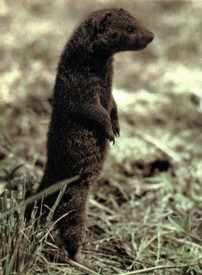

Genus:
Herpestes
Species: ichneumon

The Egyptian mongoose is the largest of all mongooses in Africa. The Egyptian mongoose lives in Africa on the savanna. The savanna is a massive grassland with scattered trees such as thorn trees, and shrubs. The savanna has two seasons, winter, which is very dry, and the summer is wet and warm. They have also been seen in southern Spain.
Egyptian mongooses live in shrub thickets, rocky areas, and small woodlands and forested areas within the savanna. These mammals prefer to live in forested areas near water. All mongooses are known for being talented snake killers. The famous novel written by Rudyard Kipling called Rikki Tikki Tavi made more people aware of the mongoose' s snake killing talents.
The Egyptian mongoose ranges anywhere from 19 to 23 inches in height. Adults weigh 4 to 7 lbs. Its tail is 13 to 21 inches long and is very bushy with a black ring at the very end. Egyptian mongooses have long hair. Their coat is usually gray with brown dots. Their coat is sometimes a reddish brown with yellow dots but this is unusual. Egyptian mongooses have a slender, low-slung body. Their heads appear to be pointed due to the shape of their snout. The animal's ears are rounded and don't project over the head due to their small size. The eyes are surrounded by a naked strip of skin. Egyptian mongooses have five finger-like claws on each short limb. The animal' s hind feet are furless. Their front claws are curved and sharp for digging in the earth. They have 35 to 40 teeth that have evolved for tearing flesh apart.
Male and female Egyptian mongooses become sexually mature at the age of two years. Their mating season is in July and August. Actual mating lasts approximately five minutes. Their gestation period lasts approximately eleven weeks and the mothers usually have 2 to 4 young. When the babies are first born they are helpless but after 6 to 8 days they can follow their mother. At birth the babies are blind and furless. The youngsters first open their eyes at 6 to 8 days old. Both of the parents raise the young, but the mother does more so than the father. The juveniles are nursed for six months and remain with their mother for the remainder of the year. When in a pack, the females/mothers take turns babysitting the young. The males/fathers baby-sit the young ones but rarely interact with them. The juveniles are dependent on the parents for approximately one year. The male youngsters usually disperse from the pack or leave their mother before the females. The females may never leave their mother or the pack. Egyptian mongooses produce a litter a year but if the first litter is killed or lost they are able to produce another. The Egyptian mongoose has been seen alone, it has been seen in pairs and it has been seen in packs. The females lead the packs and there are usually six mongooses per pack. The animal generally lives for 7 to12 years. The Egyptian mongoose is diurnal and is active all day.
Egyptian mongooses are mostly carnivorous. They also eat fruit if it is available where they are living. Their typical diet consists of rodents, fish, birds, reptiles, amphibians, insects and insect larvae. Egyptian mongooses also eat the eggs of the animals mentioned above. Egyptian mongooses claws have adapted to digging allowing them to dig bugs out of the ground. Their teeth have adapted to tearing the flesh of animals they prey on. Egyptian mongooses also eat poisonous snakes. They can run backwards, roll over, swim and stand on two hind feet. They can puff their hair up to appear two times their actual size, change directions quickly and jump. This helps the Egyptian mongoose kill snakes and any prey they encounter.
They are preyed on by birds of prey and large carnivores on the savanna. Egyptian mongooses benefit the environment by killing animals that are considered to be pests by humans such as rats and snakes.
Egyptian mongooses are able to survive in the environment for the following reasons. The color of their fur blends in with the surroundings of the savanna. The Egyptian mongooses claws also help it survive in the environment by helping it dig for food.
Egyptian mongooses are not endangered. They aren't endangered because they are shy which protects them. They are hunted because they attack people's chickens and they eat their poultry.
by Alex P. 2003
Bibliography:
Photo link:
http://www.ittiofauna.org/provinciarezzo/ufficiocaccia/
tabelle_specie/carnivori/icneumone/
"Egyptian
mongoose".
http://www.americazoo.com/goto/index/mammals/298.htm
(12/12/02).
"Egyptian
Mongoose."
http://www.lioncrusher.com/animal.asp?animal=130
(12/12/02).
Hedit, Gary A. "Mongoose." World Book. 2003 ed.
"Mongoose." Wildlife and Plants of the World. 10th ed.
Nawaz, Ambreen. "Egyptian Mongoose." Animal Action. n.d.
O'tool, Christopher, and John Stidworth. Mammals the Hunter. New York: Fact on File, 1998.
Wilson, Erin E.
"Egyptian Mongoose. "
http://animaldiversity.ummz.umich.edu/accounts/herpestes/
h._ichneumon$narrative.html
(12/12/02).